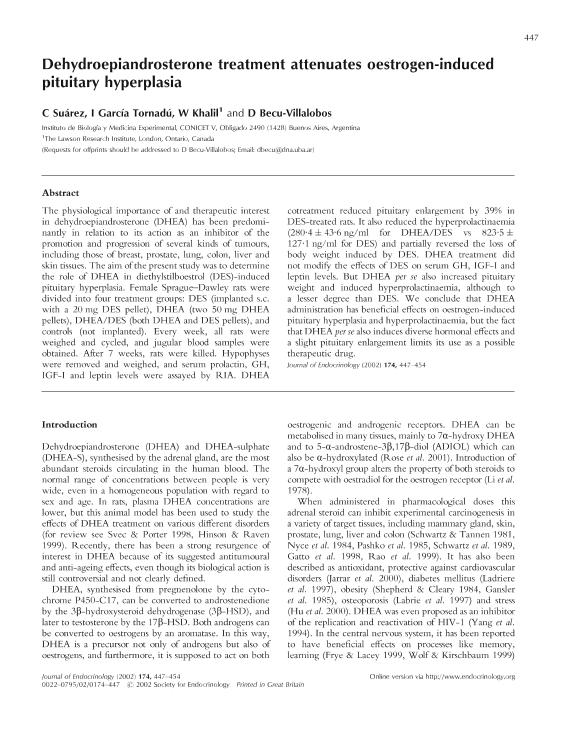Artículo
Dehydroepiandrosterone treatment attenuates oestrogen-induced pituitary hyperplasia
Fecha de publicación:
2002
Editorial:
BioScientifica
Revista:
Journal of Endocrinology
ISSN:
0022-0795
Idioma:
Inglés
Tipo de recurso:
Artículo publicado
Clasificación temática:
Resumen
The physiological importance of and therapeutic interest in dehydroepiandrosterone (DHEA) has been predominantly in relation to its action as an inhibitor of the promotion and progression of several kinds of tumours, including those of breast, prostate, lung, colon, liver and skin tissues. The aim of the present study was to determine the role of DHEA in diethylstilboestrol (DES)-induced pituitary hyperplasia. Female Sprague-Dawley rats were divided into four treatment groups: DES (implanted s.c. with a 20 mg DES pellet), DHEA (two 50 mg DHEA pellets), DHEA/DES (both DHEA and DES pellets), and controls (not implanted). Every week, all rats were weighed and cycled, and jugular blood samples were obtained. After 7 weeks, rats were killed. Hypophyses were removed and weighed, and serum prolactin, GH, IGF-I and leptin levels were assayed by RIA. DHEA cotreatment reduced pituitary enlargement by 39% in DES-treated rats. It also reduced the hyperprolactinaemia (280.4+/-43.6 ng/ml for DHEA/DES vs 823.5+/- 127.1 ng/ml for DES) and partially reversed the loss of body weight induced by DES. DHEA treatment did not modify the effects of DES on serum GH, IGF-I and leptin levels. But DHEA per se also increased pituitary weight and induced hyperprolactinaemia, although to a lesser degree than DES. We conclude that DHEA administration has beneficial effects on oestrogen-induced pituitary hyperplasia and hyperprolactinaemia, but the fact that DHEA per se also induces diverse hormonal effects and a slight pituitary enlargement limits its use as a possible therapeutic drug.
Palabras clave:
Endocrinology
,
Dhea
,
Pituitary Hyperplasia
Archivos asociados
Licencia
Identificadores
Colecciones
Articulos(IBYME)
Articulos de INST.DE BIOLOGIA Y MEDICINA EXPERIMENTAL (I)
Articulos de INST.DE BIOLOGIA Y MEDICINA EXPERIMENTAL (I)
Citación
Suárez, Cecilia Ana; Garcia Tornadu, Isabel Andrea; Khalil, W.; Becu, Damasia; Dehydroepiandrosterone treatment attenuates oestrogen-induced pituitary hyperplasia; BioScientifica; Journal of Endocrinology; 174; 3; 2002; 447-454
Compartir




